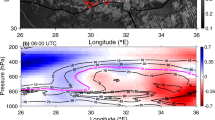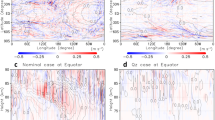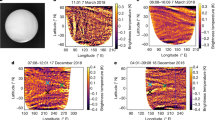Abstract
AMONG the most intriguing features of the atmosphere of Venus is the presence of cellular structures near and downwind of the subpolar point. Ultraviolet images from the Mariner 10 and Pioneer Venus missions at cloud-top heights of 60–70 km indicate that these cells are chiefly found only during the afternoon at low latitudes, with dark-rimmed cells having horizontal scales of roughly 500–1,000 km, and bright-rimmed cells having horizontal scales of roughly 200–500 km (refs 1, 2). Images of the subsolar region from the recent Galileo flyby of Venus confirm these earlier observations—cellular features with horizontal scales of 250–1,000 km have been observed3 (Fig. la,b). It has been suggested that the structures are atmospheric convection cells2–5, and, in fact, numerical simulations of three-dimensional compressible convection produce features reminiscent of the cellular structures found in the subsolar Venus atmosphere (Fig. 1c)6. There has been some difficulty, however, in accounting for the sizes of these structures. The convection cells were thought to be located in a neutrally stable cloud layer, roughly 50 km above the surface, with a thickness of only a few kilometres. So broad and thin a convection cell would pose a severe challenge to the dynamics of convection. Here we propose that strongly penetrative convection into the stable regions above and below the neutrally stable cloud layer coupled with penetrative convection from the surface increases the vertical dimensions of the cells, thereby helping to explain their large horizontal extent.
This is a preview of subscription content, access via your institution
Access options
Subscribe to this journal
Receive 51 print issues and online access
$199.00 per year
only $3.90 per issue
Buy this article
- Purchase on SpringerLink
- Instant access to full article PDF
Prices may be subject to local taxes which are calculated during checkout
Similar content being viewed by others
References
Murray, B. C. et al. Science 183, 1307–1315 (1974).
Rossow, W. B. et al. J. geophys. Res. 85, 8107–8128 (1980).
Belton, M. J. S. et al. Science 253, 1531–1536 (1991).
Belton, M. J. et al. J. atmos. Sci. 33, 1394–1417 (1976).
Covey, C. C. & G. Schubert, Nature 290, 17–20 (1981).
Toomre, J. et al. Comp. Phys. Comm. 59, 105–117 (1990).
Seiff, A. et al. J. geophys. Res. 85, 7903–7933 (1980).
Linkin, V. M. et al. Cosmic Res. 25, 501–512 (1987).
Avduevskiy, V. S. et al. Venus (eds Hunten, D. M., Colin, L., Donahue, T. M. & Moroz, V. I.) 280–298 (University of Arizona Press, 1983).
Seiff, A. Venus (eds Hunten, D. M., Colin, L., Donahue, T. M. & Moroz, V. I.) 215–279 (University of Arizona Press, 1983).
Pollack, J. B., Toon, O. B. & Boese, R. J. geophys. Res. 85, 8223–8231 (1980).
Schubert, G. et al. J. geophys. Res. 85, 8007–8025 (1980).
Tritton, D. J. Nature 257, 110–112 (1975).
Massaguer, J. M. et al. Astr. Astrophys. 140, 1–16 (1984).
Zahn, J.-P., Toomre, J. & Latour, J. Geophys. Astrophys. Fluid Dynam. 22, 159–193 (1982).
Hurlbert, N. E., Toomre, J. & Massaguer, J. M. Astrophys. J. 311, 563–577 (1986).
Schubert, G. Venus (eds Hunten, D. M., Colin, L., Donahue, T. M. & Moroz, V. I.) 681–765 (University of Arizona Press, 1983).
Hurlbert, N. E., Toomre, J. & Massaguer, J. M. Astrophys. J. 282, 557–573 (1984).
Agee, E. M., Chen, T. S. & Dowell, K. E. Bull. Am. met. Soc. 54, 1004–1012 (1973).
Schinder, P. J., et al. J. atmos. Sci. 47, 2037–2052 (1990).
Author information
Authors and Affiliations
Rights and permissions
About this article
Cite this article
Baker II, R., Schubert, G. Cellular convection in the atmosphere of Venus. Nature 355, 710–712 (1992). https://doi.org/10.1038/355710a0
Received:
Accepted:
Issue date:
DOI: https://doi.org/10.1038/355710a0
This article is cited by
-
Morphology and dynamics of the upper cloud layer of Venus
Nature (2007)
-
Atmospheric cellular convection
Nature (1992)
-
Atmospheric cellular convection
Nature (1992)



